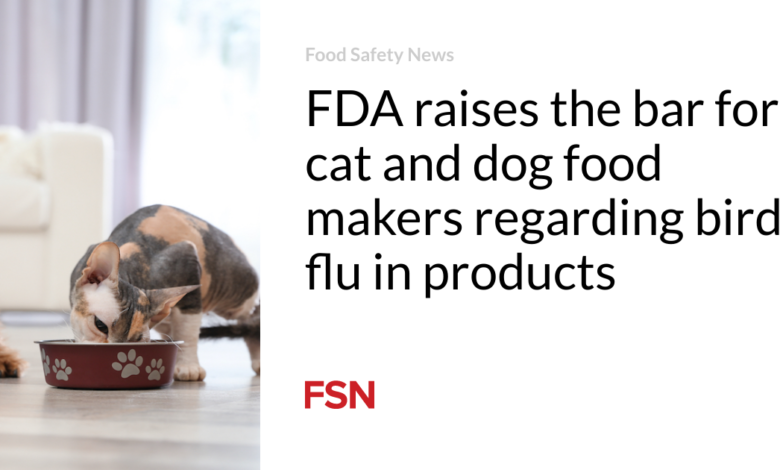FDA raises the bar for cat and dog food makers regarding bird flu in products

The Food and Drug Administration has determined that it is necessary for manufacturers of cat and dog foods who are covered by the FDA Food Safety Modernization Act Preventive Controls for Animal Food rule and using uncooked or unpasteurized materials derived from poultry or cattle to reanalyze their food safety plans to include Highly Pathogenic Avian Influenza virus (specifically H5N1) as a known or reasonably foreseeable hazard.
Furthermore, the FDA is issuing this update to ensure that cat and dog food manufacturers are aware of information about the new H5N1 hazard associated with their pet food products, which is an additional reason that manufacturers must conduct a reanalysis of their food safety plans.
The FDA is tracking cases of H5N1 in domestic and wild cats in California, Colorado, Oregon and Washington that are associated with eating contaminated food products. Scientific information is evolving, but at this time it is known that H5N1 can be transmitted to cats and dogs when they eat products from infected poultry or cattle such as unpasteurized milk, uncooked meat, or unpasteurized eggs, that have not undergone a processing step that is capable of inactivating the virus, such as pasteurizing, cooking or canning.
Cats, domestic and large felids, in particular can experience severe illness or death from infection with H5N1. Dogs can also contract H5N1, although they usually exhibit mild clinical signs and low mortality compared to cats. At present, H5N1 has not been detected in dogs in the United States, but there have been fatal cases in other countries.
The FDA Food Safety Modernization Act Preventive Controls for Animal Food (PCAF) rule requires that certain animal food businesses develop a food safety plan. In this food safety plan, animal food businesses must identify and evaluate known or reasonably foreseeable hazards for each type of animal food manufactured, processed, packed, or held at their facility to determine whether there are any hazards requiring a preventive control. Businesses must identify these hazards based on experience, illness data, scientific reports, and other information.
In the hazard evaluation, animal food businesses must assess the severity of the illness or injury to humans or animals if the hazard were to occur and the probability that the hazard will occur in the absence of preventive controls.
The animal food industry can find guidance related to these requirements in the FDA’s Center for Veterinary Medicine’s Guidance for Industry #245, “Hazard Analysis and Risk-Based Preventive Controls for Food for Animals.”
Under the Food Safety Modernization Act requirements, animal food businesses must conduct a reanalysis of their food safety plan when the FDA determines it is necessary to respond to new hazards and developments in scientific understanding.
The FDA has determined that it is necessary for cat and dog food manufacturers covered by the PCAF rule, who are using uncooked or unpasteurized materials derived from poultry or cattle including uncooked meat, unpasteurized milk, unpasteurized eggs, in cat or dog food, to reanalyze their food safety plans to include H5N1 as a new known or reasonably foreseeable hazard.
The reanalysis is necessary to respond to the recent domestic cat illnesses and deaths and to scientific data indicating that cats and dogs have become ill from consuming H5N1 virus.
Manufacturers that implement a preventive control for the H5N1 hazard as a result of their reanalysis will be taking an important step toward protecting cat and dog health and helping to prevent spread of H5N1. Addressing H5N1 will require a concerted effort across sectors, including by government, businesses, and consumers.
Manufacturers also are required to conduct a reanalysis of their food safety plans when they become aware of new information about potential hazards associated with animal food.
“As we learn more about the transmission of H5N1 in animal food, there are several practices that the FDA is encouraging pet food manufacturers and others in the supply chain to use to significantly minimize or prevent H5N1 transmission through animal food,” according to the FDA.
“These practices include seeking ingredients from flocks or herds that are healthy, and taking processing steps, such as heat treatment, that are capable of inactivating viruses. For example, some businesses already implement a heat treatment step that is capable of inactivating the virus as a process control. Heat treatments have been shown to be effective for inactivating H5N1 in meat, milk, and egg products. A different practice would be to implement a supply-chain-applied control to provide assurance that ingredients used in animal food do not come from H5N1-infected animals.”
USDA’s Food Safety and Inspection Service, Animal and Plant Health Inspection Service, and Agricultural Research Service (ARS) have completed multiple studies to confirm that meat, poultry and eggs that are properly prepared and cooked are safe to eat. Additionally, to verify the safety of the meat these agencies have completed three separate beef safety studies related to avian influenza in meat from dairy cattle. Furthermore, USDA and the U.S. Food and Drug Administration (FDA) have performed multiple retail sampling studies to reaffirm the safety of the pasteurized milk supply and pasteurized milk products.
(To sign up for a free subscription to Food Safety News,click here)



